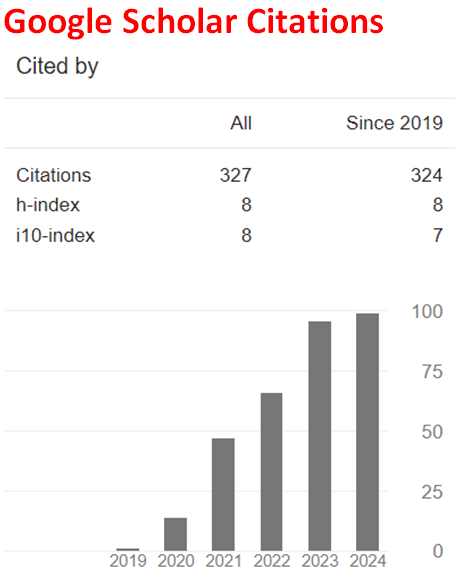Bio-sorption of Methylene Blue by Defatted Seed of Adansonia digitata
Abstract
The study was carried to evaluate the ability of defatted seed of Adansonia digitata (DFSE) to remove methylene blue dye from contaminated water. The optimum parameters such as contact time, particle size, absorbent dose, initial dye concentration, and pH were investigated by performing batch experiments models. The kinetics and the isotherms adsorption were evaluated by varying the initial concentration and using the optimum parameters. The optimum of contact time is 90 min and the removal capacity is 99.34 %. A mass of 700 mg is sufficient to reach the maximum removal of methylene blue (99.44 %). The maximum adsorption is obtained with an initial methylene blue concentration of 75 ppm (98.53 %). The optimum particle size is 100 mm. The kinetics of the adsorption process are in accordance with the pseudo-second order model. Experimental values of the adsorption capacity are close proximity to the optimum values predicted by the pseudo-second order model. The Langmuir, Freundlich, Dubinin-Radushkevich and Tempkin isotherms are not suitable to explain the experimental isotherm.
References
Wang, L.K., Hung, Y.-T., Lo, H.H., & Yapijakis, C. (2005). Waste treatment in the process industries. CRC Press.
Jassim, S.A-R., Al-Robai, H.A., & Al-Taee, M.M. (2013). Removing reactive orange dye by using ceramic purifier type (AKPL1). Iraqi National Journal of Chemistry, 50, 121‑127. https://www.iasj.net/iasj/download/a92ccbe46ea07d2f
Husein, M.M., Vera, J.H., & Weber, M.E. (2008). Removal of lead from aqueous solutions with sodium caprate. Separation Science and Technology, 33, 1889-1904. https://doi.org/10.1080/01496399808545911
Choumane, R., & Peulon, S. (2019). Electrodeposited birnessite thin film: An efficient eco-friendly sorbent for removing heavy metals from water. Colloids and Surfaces A: Physicochemical and Engineering Aspects, 577, 594‑603. https://doi.org/10.1016/j.colsurfa.2019.06.013
Ducoroy, L., Bacquet, M., Martel, B., & Morcellet, M. (2008). Removal of heavy metals from aqueous media by cation exchange nonwoven PET coated with β-cyclodextrin-polycarboxylic moieties. Reactive and Functional Polymers, 68, 594‑600. https://doi.org/10.1016/j.reactfunctpolym.2007.10.033
Bassaid, S., Chaib, M., Bouguelia, A., & Trari, M. (2008). Elaboration and characterization of poly (acrylic acid-co-crotonic acid) copolymers: Application to extraction of metal cations Pb(II), Cd(II) and Hg(II) by complexation in aqueous media. Reactive and Functional Polymers, 68, 483‑491. https://doi.org/10.1016/j.reactfunctpolym.2007.10.030
Li, L., Wei, D., Wei, G., & Du, Y. (2013). Transformation of cefazolin during chlorination process: Products, mechanism and genotoxicity assessment. Journal of Hazardous Materials, 262, 48‑54. https://doi.org/10.1016/j.jhazmat.2013.08.029
Volesky, B., & Holan, Z.R. (1995). Biosorption of heavy metals. Biotechnology Progress, 11, 235-250. http://dx.doi.org/10.1021/bp00033a001
Shaul, G.M., Holdsworth, T.J., Dempsey, C.R., & Dostal, K.A. (1991). Fate of water soluble azo dyes in the activated sludge process. Chemosphere, 22, 107‑119. http://dx.doi.org/10.1016/0045-6535(91)90269-J
He, J., Cui, A., Deng, S., & Chen, J.P. (2018). Treatment of methylene blue containing wastewater by a cost-effective micro-scale biochar/polysulfone mixed matrix hollow fiber membrane: Performance and mechanism studies. Journal of Colloid and Interface Science, 512, 190‑197. http://dx.doi.org/10.1016/j.jcis.2017.09.106
Akrout, H., Jellali, S., & Bousselmi, L. (2015). Enhancement of methylene blue removal by anodic oxidation using BDD electrode combined with adsorption onto sawdust. Comptes Rendus Chimie, 18, 110‑120. http://dx.doi.org/10.1016/j.crci.2014.09.006
Naushad, M., Sharma, G., & Alothman, Z.A. (2019). Photodegradation of toxic dye using Gum Arabic-crosslinked-poly(acrylamide)/Ni(OH)2/FeOOH nanocomposites hydrogel. Journal of Cleaner Production, 241, 118263. http://dx.doi.org/10.1016/j.jclepro.2019.118263
Bharti, V., Vikrant, K., Goswami, M., Tiwari, H., Sonwani, R.K., Lee, J., Tsang, D.C.W., Kim, K-H., Saeed, M., Kumar, S., Rai, B.N., Giri, B.S., & Singha, R.S. (2019). Biodegradation of methylene blue dye in a batch and continuous mode using biochar as packing media. Environmental Research, 171, 356‑364. http://dx.doi.org/10.1016/j.envres.2019.01.051
Vijayaraghavan, K., & Yun, Y.-S. (2008). Bacterial biosorbents and biosorption. Biotechnology Advances, 26, 266‑291. http://dx.doi.org/10.1016/j.biotechadv.2008.02.002
Aksu, Z., & Karabayır, G. (2008). Comparison of biosorption properties of different kinds of fungi for the removal of Gryfalan Black RL metal-complex dye. Bioresource Technology, 99, 7730‑7741. http://dx.doi.org/10.1016/j.biortech.2008.01.056
Mengting, Z., Kurniawan, T.A., Fei, S., Ouyang, T., Othman, M.H.D., Rezakazemi, M., & Shirazian, S. (2019). Applicability of BaTiO3/graphene oxide (GO) composite for enhanced photodegradation of methylene blue (MB) in synthetic wastewater under UV–vis irradiation. Environmental Pollution, 255, 113182. http://dx.doi.org/10.1016/j.envpol.2019.113182
Su, S., Liu, Y., Liu, X., Jin, W., & Zhao, Y. (2019). Transformation pathway and degradation mechanism of methylene blue through β-FeOOH@GO catalyzed photo-Fenton-like system. Chemosphere, 218, 83‑92. http://dx.doi.org/10.1016/j.chemosphere.2018.11.098
Malato, S., Fernández-Ibáñez, P., Maldonado, M.I., Blanco, J., & Gernjak, W. (2009). Decontamination and disinfection of water by solar photocatalysis: Recent overview and trends. Catalysis Today, 147, 1‑59. http://dx.doi.org/10.1016/j.cattod.2009.06.018
Royer, B., Cardoso, N.F., Lima, E.C., Vaghetti, J.C.P., Simon, N.M., Calvete, T., & Veses, R.C. (2009). Applications of Brazilian pine-fruit shell in natural and carbonized forms as adsorbents to removal of methylene blue from aqueous solutions—Kinetic and equilibrium study. Journal of Hazardous Materials, 164, 1213‑1222. http://dx.doi.org/10.1016/j.jhazmat.2008.09.028
Bhatnagar, A., & Sillanpää, M. (2010). Utilization of agro-industrial and municipal waste materials as potential adsorbents for water treatment—A review, Chemical Engineering Journal, 157, 277‑296. http://dx.doi.org/10.1016/j.cej.2010.01.007
Albert, M., Lessin, M.S., & Gilchrist, B.F. (2003). Methylene blue: dangerous dye for neonates, Journal of Pediatric Surgery, 38, 1244‑1245. http://dx.doi.org/10.1016/S0022-3468(03)00278-1
Tarley, C.R.T., & Arruda, M.A.Z. (2004). Biosorption of heavy metals using rice milling by-products. Characterisation and application for removal of metals from aqueous effluents. Chemosphere, 54, 987‑995. http://dx.doi.org/10.1016/j.chemosphere.2003.09.001
Rizzi, V., Gubitosa, J., Signorile, R., Fini, P., Cecone, C., Matencio, A., Trotta, F., & Cosma, P. (2021). Cyclodextrin nanosponges as adsorbent material to remove hazardous pollutants from water: The case of ciprofloxacin, Chemical Engineering Journal, 411, 128514. http://dx.doi.org/10.1016/j.cej.2021.128514
Shahwan, T. (2015). Lagergren equation: Can maximum loading of sorption replace equilibrium loading?. Chemical Engineering Research and Design, 96, 172‑176. http://dx.doi.org/10.1016/j.cherd.2015.03.001
Aichour, A., & Zaghouane-Boudiaf, H. (2019). Highly brilliant green removal from wastewater by mesoporous adsorbents: Kinetics, thermodynamics and equilibrium isotherm studies. Microchemical Journal, 146, 1255‑1262. http://dx.doi.org/10.1016/j.microc.2019.02.040
Weber, Walter J., & Morris, J. Carrell (1963). Kinetics of adsorption on carbon from solution. Journal of the Sanitary Engineering Division, 89, 31‑59. http://dx.doi.org/10.1061/JSEDAI.0000430
Cope, F.W. (1972). Generalizations of the Roginsky-Zeldovich (or Elovich) equation for charge transport across biological surfaces. Bulletin of Mathematical Biophysics, 34, 419-427. https://doi.org/10.1007/BF02476452

This work is licensed under a Creative Commons Attribution 4.0 International License.


